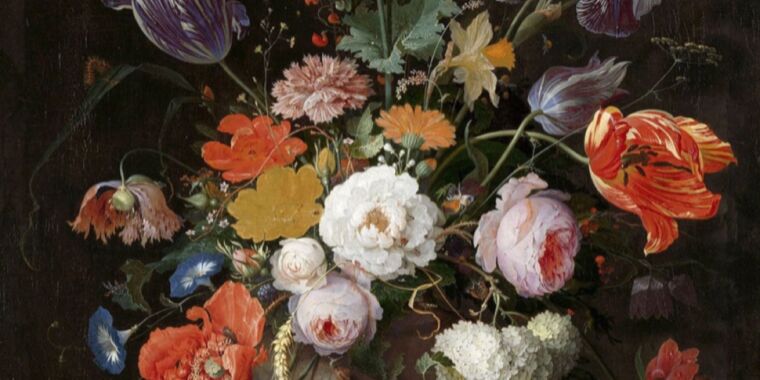
The 17th-century still life painter Abraham Mignon was known for his depictions of flowers, fruit, forests and caves, among other things. But over time, certain pigments have deteriorated to such an extent that the artist’s intent has changed. Notably, a yellow rose that features prominently in Mignon’s Still life with flowers and a watch has become flattened and monochromatic, especially when compared to the other flowers in the painting.
A team of Dutch and Belgian scientists used chemical and optical imaging techniques to investigate the elemental distribution of the different pigments, according to a recent article published in the journal Science Advances. In this way, they were able to derive Mignon’s original painting technique – specifically how the artist built up layers to create what would have been a 3D look to the original rose.
According to the authors, artists’ pigments and binders in oil paintings inevitably deteriorate over time when exposed to external factors such as light, relative humidity, temperature and/or exposure to solvents, as well as incompatible pigment mixtures. The result was discoloration and color changes that can affect the structural integrity of the paint, resulting in defects such as loss of transparency, brittleness or micro-cracks.
Examples of this kind of degradation are the discoloration of a blue glass pigment that Rembrandt used in several paintings; the fading of light-sensitive pigments – Prussian blue, organic yellow and red lacquer pigments – and the darkening of chromium and cadmium yellow in the works of Edvard Munch, Vincent van Gogh and Pablo Picasso, among other great artists.
N. de Keyser et al., 2022
“In advanced stages, these phenomena can reduce the legibility of the artwork and thereby significantly alter the artist’s intention,” they wrote. That includes changing intended optical effects, such as the folds of curtains, which can disappear, making the object appear flat. This happened, for example, with the ultramarine degradation in Jan van Eyck’s Three Marys at the Tomb† Also the fading of red pigments in Van Gogh’s The bedroom purple walls turned blue and a pink floor turned brown – an inverted optical effect.
The yellow rose of Mignon—a signature flower among 17th-century still-life painters, according to the authors—has suffered a similar fate. The rose provides “an exemplary subject for this study, appearing flat and showing little color contrast, while having a crumbling powdery appearance or a significantly broken paint surface,” the authors wrote, adding that the rose makes up most of its 3D image. lost character, especially when compared to the other better preserved flowers in the painting.

